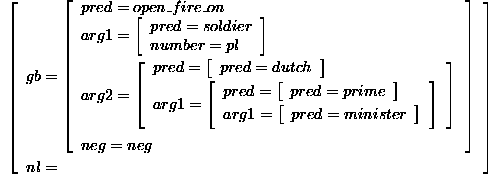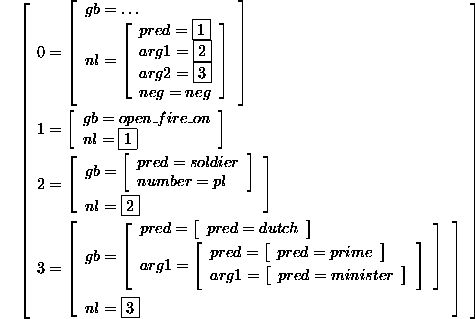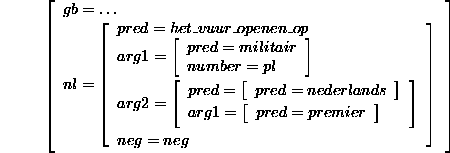


Next: Concluding Remarks Up: Illustration Previous: Negation
Transfer examples
A unification grammar defines the transfer relation between logical forms of two languages. Like in generation, the `input attribute' is a logical form. Instead of strings, logical forms of the target language are generated. For example the input to transfer may be a feature structure such as:

for a
sentence such as `The soldiers have not opened fire on the Dutch prime minister' where
 contains the English logical form and
contains the English logical form and  the Dutch logical form
the Dutch logical form
 .
.
The bilingual grammar will apply its rules, testing after each
application whether the value of the attribute  subsumes
the input feature structure. The value of the attribute
subsumes
the input feature structure. The value of the attribute  will gradually be instantiated. At the end of the process,
the system will test whether the input feature structure subsumes
the value of the attribute
will gradually be instantiated. At the end of the process,
the system will test whether the input feature structure subsumes
the value of the attribute  . If this is the case,
then the value of
. If this is the case,
then the value of  will be considered the output of transfer.
An example of a simple rule in PATR notation is given as:
will be considered the output of transfer.
An example of a simple rule in PATR notation is given as:

The integers  are names of feature structures, where
are names of feature structures, where  is used to represent the mother node and
is used to represent the mother node and  represent
the daughter nodes. Application of this rule to the feature
structure results in the following instantiation,
where framed integers represent reentrancies. Transfer then continues by instantiating
the feature structures 1, 2 and 3.
The Dutch logical form is thus gradually instantiated as transfer proceeds by decomposing the
English logical form:
represent
the daughter nodes. Application of this rule to the feature
structure results in the following instantiation,
where framed integers represent reentrancies. Transfer then continues by instantiating
the feature structures 1, 2 and 3.
The Dutch logical form is thus gradually instantiated as transfer proceeds by decomposing the
English logical form:

An example of the rule for the first daughter will be a `lexical entry' and may look as in:

The complex English expression `prime minister' has to be translated as a simple expression in Dutch: `premier'. This rule can be defined as:

where it is
assumed that the construction is analysed in English as an ordinary noun-adjective construction,
and where the logical form of the adjective takes the logical form of the noun as its argument.
Note that this example of complex transfer is similar to the famous `schimmel - white horse'
case.
As a result of the rule applications the value of the  attribute
will get instantiated resulting in:
attribute
will get instantiated resulting in:

from which the generator generates the string `De militairen hebben het vuur niet geopend op de Nederlandse premier'.
Further examples and some discussion can be found in [45][44].



Next: Concluding Remarks Up: Illustration Previous: Negation
Gertjan van Noord
Thu Nov 24 18:57:05 MET 1994